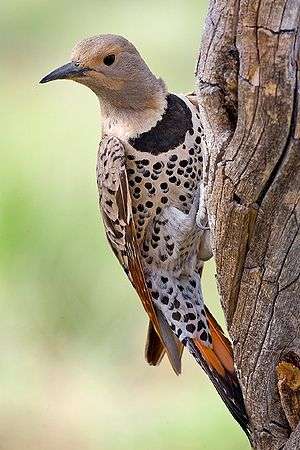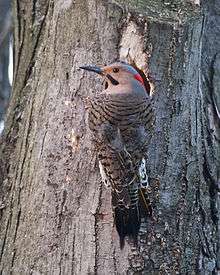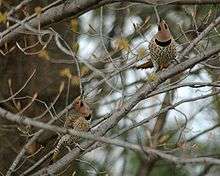Northern flicker
| Northern flicker | |
|---|---|
 | |
| Female C. a. auratus | |
 | |
| Male C. a. auratus | |
| Scientific classification | |
| Kingdom: | Animalia |
| Phylum: | Chordata |
| Class: | Aves |
| Order: | Piciformes |
| Family: | Picidae |
| Genus: | Colaptes |
| Species: | C. auratus |
| Binomial name | |
| Colaptes auratus (Linnaeus, 1758) | |
 | |
| Summer only range Winter only range Year-round range | |
| Synonyms | |
| |
The northern flicker (Colaptes auratus) is a medium-sized member of the woodpecker family. It is native to most of North America, parts of Central America, Cuba, and the Cayman Islands, and is one of the few woodpecker species that migrate. Over 100 common names for the northern flicker are known. Among them are: "yellowhammer" (not to be confused with the Eurasian yellowhammer), clape, gaffer woodpecker, harry-wicket, heigh-ho, wake-up, walk-up, wick-up, yarrup, and gawker bird. Many of these names are attempts at imitating some of its calls.
Taxonomy
The northern flicker is part of the genus Colaptes, which encompasses 12 New World woodpeckers. Nine subspecies and one extinct subspecies of C. auratus are recognized.[2] The existing subspecies were at one time considered separate species, but they commonly interbreed where ranges overlap and are now considered one species by the American Ornithologists Union. This is an example of the "species problem".
- The yellow-shafted flicker (C. a. auratus) resides in eastern North America. They are yellow under the tail and underwings and have yellow shafts on their primaries. They have a grey cap, a beige face, and a red bar at the nape of their neck. Males have a black moustache. Colaptes comes from the Greek verb colapt, to peck. Auratus is from the Latin root aurat, meaning "gold" or "golden" and refers to the bird's underwing.
- As the state bird of Alabama[3] it is known by the name "yellowhammer," a term that originated during the American Civil War to describe Confederate soldiers from Alabama.[4]
- The red-shafted flicker (C. a. cafer) resides in western North America. They are red under the tail and underwings and have red shafts on their primaries. They have a beige cap and a grey face. Males have a red moustache. The subspecific name, C. a. cafer, is the result of an error made in 1788 by the German systematist Johann Gmelin, who believed that its original habitat was in South Africa among the Xhosa people, then known as the "Kaffirs".
- The †Guadalupe flicker (C. a./cafer rufipileus), extinct circa 1910
 C. a. cafer: female (left), male (right)
C. a. cafer: female (left), male (right)- C. a. chrysocaulosus
female, Cuba
Description
Adults are brown with black bars on the back and wings. A mid- to large-sized woodpecker measures 28–36 cm (11–14 in) in length and 42–54 cm (17–21 in) in wingspan.[5][6] The body mass can vary from 86 to 167 g (3.0 to 5.9 oz).[7] Among standard scientific measurements, the wing bone measures 12.2–17.1 cm (4.8–6.7 in), the tail measures 7.5–11.5 cm (3.0–4.5 in), the bill measures 2.2–4.3 cm (0.87–1.69 in) and the tarsus measures 2.2–3.1 cm (0.87–1.22 in). The largest-bodied specimens are from the northern stretches of the species range, at the latitude of Alaska and Labrador, while the smallest specimens come from Grand Cayman Island.[8] A necklace-like black patch occupies the upper breast, while the lower breast and belly are beige with black spots. Males can be identified by a black or red moustachial stripe at the base of the beak. The tail is dark on top, transitioning to a white rump which is conspicuous in flight.
The subspecies' plumage varies as described in Taxonomy.
Call and flight
This bird's call is a sustained laugh, ki ki ki ki, more congenial than that of the pileated woodpecker. One may also hear a constant knocking as they often drum on trees or even metal objects to declare territory. Like most woodpeckers, northern flickers drum on objects as a form of communication and territory defense. In such cases, the object is to make as loud a noise as possible, so woodpeckers sometimes drum on metal objects.
 |
Northern flicker
Long Island, NY, August 1996, by Tony Phillips |
| Problems playing this file? See media help. | |
Like many woodpeckers, its flight is undulating. The repeated cycle of a quick succession of flaps followed by a pause creates an effect comparable to a rollercoaster.
.jpg)
Behavior
Diet
According to the Audubon field guide, "flickers are the only woodpeckers that frequently feed on the ground", probing with their beak, also sometimes catching insects in flight. Although they eat fruits, berries, seeds, and nuts, their primary food is insects. Ants alone can make up 45% of their diet. Other invertebrates eaten include flies, butterflies, moths, beetles, and snails. Flickers also eat berries and seeds, especially in winter, including poison oak and poison ivy, dogwood, sumac, wild cherry, grape, bayberries, hackberries, and elderberries, as well as sunflower and thistle seeds. Flickers often break into underground ant colonies to get at the nutritious larvae there, hammering at the soil the way other woodpeckers drill into wood. They have been observed breaking up cow dung to eat insects living within. Their tongues can dart out 50 mm (2.0 in) beyond the end of the bill to catch prey. As well as eating ants, flickers have a behavior called anting, during which they use the formic acid from the ants to assist in preening, as it is useful in keeping them free of parasites.
Habitat
Flickers may be observed in open habitats near trees, including woodlands, edges, yards, and parks. In the western United States, one can find them in mountain forests all the way up to tree line. Northern flickers generally nest in holes in trees like other woodpeckers. Occasionally, they have been found nesting in old, earthen burrows vacated by belted kingfishers or bank swallows. Both sexes help with nest excavation. The entrance hole is about 7.6 cm (3.0 in) in diameter, and the cavity is 33–41 cm (13–16 in) deep. The cavity widens at bottom to make room for eggs and the incubating adult. Inside, the cavity is bare except for a bed of wood chips for the eggs and chicks to rest on. Once nestlings are about 17 days old, they begin clinging to the cavity wall rather than lying on the floor.
Lifespan
The oldest yet known "yellow-shafted" northern flicker lived to be at least 9 years 2 months old, and the oldest yet known “red-shafted” northern flicker lived to be at least 8 years 9 months old.[9]
Reproduction

Their breeding habitat consists of forested areas across North America and as far south as Central America. They are cavity nesters which typically nest in trees, but they also use posts and birdhouses if sized and situated appropriately. They prefer to excavate their own home, although they reuse and repair damaged or abandoned nests. Abandoned flicker nests create habitat for other cavity nesters. Flickers are sometimes driven from nesting sites by another cavity nester, the European starling.
About 1 to 2 weeks are needed for a mated pair to build the nest. The entrance hole is roughly 5 to 10 cm (2.0 to 3.9 in) wide.

A typical clutch consists of six to eight eggs whose shells are pure white with a smooth surface and high gloss. The eggs are the second-largest of the North American woodpecker species, exceeded only by the pileated woodpecker's. Incubation is by both sexes for about 11 to 12 days. The young are fed by regurgitation and fledge about 25 to 28 days after hatching.
Wintering and migration
Northern birds migrate to the southern parts of the range; southern birds are often permanent residents.
References
- ↑ BirdLife International (2012). "Colaptes auratus". IUCN Red List of Threatened Species. Version 2013.2. International Union for Conservation of Nature. Retrieved 26 November 2013.
- ↑ "Colaptes auratus report". ITIS Report. Integrated Taxonomic Information System. Retrieved 27 March 2016.
- ↑ "Alabama State Bird". Alabama Emblems, Symbols and Honors. Alabama Department of Archives & History. 2006-04-27. Retrieved 2007-03-18.
- ↑ Record, James (1970). A Dream Come True: The Story of Madison County and Incidentally of Alabama and the United States. Huntsville, Alabama: John Hicklin Printing Company. p. 128.
- ↑ (2011).
- ↑ (2011).
- ↑ CRC Handbook of Avian Body Masses by John B. Dunning Jr. (Editor). CRC Press (1992), ISBN 978-0-8493-4258-5.
- ↑ Woodpeckers: An Identification Guide to the Woodpeckers of the World by Hans Winkler, David A. Christie & David Nurney. Houghton Mifflin (1995), ISBN 978-0-395-72043-1
- ↑ "Northern Flicker". The Cornell Lab of Ornithology (All About Birds). Retrieved 2015-10-03.
External links
| Wikimedia Commons has media related to Northern flicker. |
| Wikispecies has information related to: Colaptes auratus |
- Northern Flicker Species Account - Cornell Lab of Ornithology
- Northern Flicker - Colaptes auratus - USGS Patuxent Bird Identification InfoCenter
- A sample of the call of a Northern Flicker by the USGS
- Stamps (for Antigua, Cayman Islands, Cuba, Saint Pierre and Miquelon, United States) (imperfect Range Map) at bird-stamps.org
- "Northern Flicker media". Internet Bird Collection.
- Northern flicker photo gallery at VIREO (Drexel University)
- Calls of the northern flicker at Animal Diversity Web
- Northern (Yellow-shafted) Flicker Bird Sound at Florida Museum of Natural History
